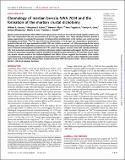Files in this item
Chronology of martian breccia NWA 7034 and the formation of the martian crustal dichotomy
Item metadata
| dc.contributor.author | Cassata, William S. | |
| dc.contributor.author | Cohen, Benjamin E. | |
| dc.contributor.author | Mark, Darren F. | |
| dc.contributor.author | Trappitsch, Reto | |
| dc.contributor.author | Crow, Carolyn A. | |
| dc.contributor.author | Wimpenny, Joshua | |
| dc.contributor.author | Lee, Martin R. | |
| dc.contributor.author | Smith, Caroline L. | |
| dc.date.accessioned | 2018-06-07T11:30:08Z | |
| dc.date.available | 2018-06-07T11:30:08Z | |
| dc.date.issued | 2018-05-23 | |
| dc.identifier | 253303088 | |
| dc.identifier | fb67730d-b1fc-4a04-b28e-81a67b5c6e88 | |
| dc.identifier | 85047464619 | |
| dc.identifier | 000443174800003 | |
| dc.identifier.citation | Cassata , W S , Cohen , B E , Mark , D F , Trappitsch , R , Crow , C A , Wimpenny , J , Lee , M R & Smith , C L 2018 , ' Chronology of martian breccia NWA 7034 and the formation of the martian crustal dichotomy ' , Science Advances , vol. 4 , no. 5 , eaap8306 . https://doi.org/10.1126/sciadv.aap8306 | en |
| dc.identifier.issn | 2375-2548 | |
| dc.identifier.uri | https://hdl.handle.net/10023/13813 | |
| dc.description | This work was performed under the auspices of the U.S. Department of Energy by LLNL under contract DE-AC52-07NA27344. Financial support was provided by the NASA Mars Fundamental Research Program (grant NNH14AX56I to W.S.C.) and an LLNL Laboratory Directed Research and Development project (17-ERD-001), “Uncovering the Origins of the Solar System with Cosmochemical Forensics.” The UK work component was funded by the Science and Technology Facilities Council (grants ST/H002472/1, ST/H002960/1, and ST/K000918/1 to D.F.M. and M.R.L.). NERC is thanked for continued funding of the Argon Isotope Facility at SUERC. | en |
| dc.description.abstract | Martian meteorite Northwest Africa (NWA) 7034 and its paired stones are the only brecciated regolith samples from Mars with compositions that are representative of the average martian crust. These samples therefore provide a unique opportunity to constrain the processes of metamorphism and alteration in the martian crust, which we have investigated via U-Pu/Xe, 40Ar/39Ar, and U-Th-Sm/He chronometry. U-Pu/Xe ages are comparable to previously reported Sm-Nd and U-Pb ages obtained from NWA 7034 and confirm an ancient (>4.3 billion years) age for the source lithology. After almost 3000 million years (Ma) of quiescence, the source terrain experienced several hundred million years of thermal metamorphism recorded by the K-Ar system that appears to have varied both spatially and temporally. Such protracted metamorphism is consistent with plume-related magmatism and suggests that the source terrain covered an areal extent comparable to plume-fed edifices (hundreds of square kilometers). The retention of such expansive, ancient volcanic terrains in the southern highlands over billions of years suggests that formation of the martian crustal dichotomy, a topographic and geophysical divide between the heavily cratered southern highlands and smoother plains of the northern lowlands, likely predates emplacement of the NWA 7034 source terrain—that is, it formed within the first ~100 Ma of planetary formation. | |
| dc.format.extent | 12 | |
| dc.format.extent | 535759 | |
| dc.language.iso | eng | |
| dc.relation.ispartof | Science Advances | en |
| dc.subject | GE Environmental Sciences | en |
| dc.subject | DAS | en |
| dc.subject.lcc | GE | en |
| dc.title | Chronology of martian breccia NWA 7034 and the formation of the martian crustal dichotomy | en |
| dc.type | Journal article | en |
| dc.contributor.institution | University of St Andrews. School of Earth & Environmental Sciences | en |
| dc.identifier.doi | https://doi.org/10.1126/sciadv.aap8306 | |
| dc.description.status | Peer reviewed | en |
This item appears in the following Collection(s)
Items in the St Andrews Research Repository are protected by copyright, with all rights reserved, unless otherwise indicated.

